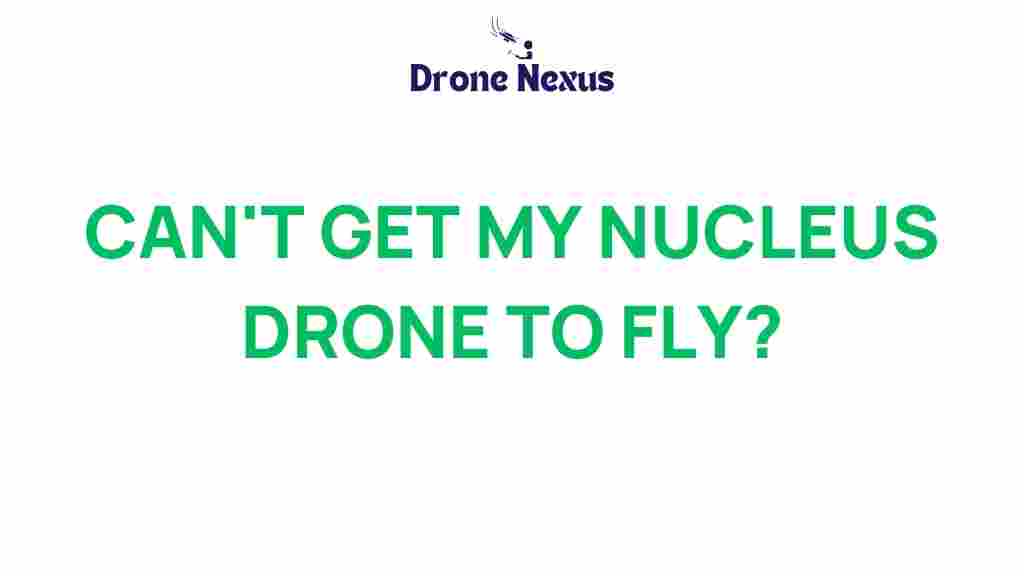Unlocking the Secrets: Why Your Nucleus Drone Won’t Take Flight
In the world of aerial technology, drones have revolutionized how we capture images, inspect infrastructure, and explore the skies. Among the various models available, the Nucleus drone stands out for its advanced features and user-friendly design. However, like any piece of technology, it can encounter issues that prevent it from taking flight. If you find yourself facing this frustrating situation, you’re not alone. In this article, we will delve into the common reasons your Nucleus drone won’t take off and provide step-by-step troubleshooting tips to help you get back in the air.
Understanding the Nucleus Drone
Before we dive into the troubleshooting process, it’s essential to understand what makes the Nucleus drone unique. This drone is equipped with cutting-edge technology, designed for both hobbyists and professionals. It boasts features such as:
- High-resolution camera: Perfect for capturing stunning aerial photographs and videos.
- Stabilization system: Ensures smooth flight and clear footage.
- GPS capabilities: Allows for precise navigation and positioning.
- Intuitive controls: Makes it accessible for users of all skill levels.
Despite these impressive features, users may experience issues that prevent the drone from taking off. Let’s explore some of the most common reasons.
Common Reasons Your Nucleus Drone Won’t Take Flight
1. Battery Issues
The most frequent cause of a drone not taking off is battery-related problems. If your Nucleus drone isn’t flying, check the following:
- Battery Charge: Ensure the battery is fully charged. A low charge can prevent takeoff.
- Battery Connections: Inspect the battery connections for any loose or corroded terminals.
- Battery Health: Over time, batteries can degrade. If your battery is old, it may need replacing.
2. Firmware Updates
Keeping your Nucleus drone’s firmware up to date is crucial for optimal performance. Outdated firmware can lead to various issues, including flight failures. To check for updates:
- Connect your drone to the companion app.
- Navigate to the settings menu.
- Look for firmware updates and install if available.
3. GPS Signal Issues
A stable GPS signal is essential for the proper functioning of your Nucleus drone. Here are things you can do to troubleshoot GPS problems:
- Location: Ensure you are in an open area away from tall buildings or trees that could obstruct the GPS signal.
- Startup Time: Allow the drone enough time to acquire a GPS signal before attempting takeoff.
- Calibration: Perform a compass calibration if GPS issues persist.
4. Propeller Problems
Another common issue that can prevent your Nucleus drone from taking off is propeller malfunction. To address this:
- Inspection: Check the propellers for any signs of damage or wear.
- Installation: Ensure that all propellers are correctly installed and secured.
- Replacement: If damaged, replace the propellers with new ones designed for your Nucleus drone.
5. Remote Control Issues
The connection between your remote control and the Nucleus drone is vital for flight. If you are experiencing issues, consider the following:
- Battery Check: Ensure the remote control is powered by a fully charged battery.
- Signal Interference: Look for possible interference from other electronic devices.
- Pairing: Re-pair the remote control with the drone if the connection seems weak.
Step-by-Step Troubleshooting Process
Now that we’ve covered the common reasons why your Nucleus drone may not take flight, let’s go through a systematic troubleshooting process to identify and fix the problem.
Step 1: Check the Battery
Start by examining the battery. Charge it fully and inspect the terminals. If everything looks good, proceed to the next step.
Step 2: Verify Firmware
Connect to the companion app and check for any available firmware updates. If an update is necessary, install it and restart your drone.
Step 3: Assess the GPS Signal
Ensure you’re in an open area and allow the drone time to connect to the GPS. If it still doesn’t connect, try calibrating the compass.
Step 4: Inspect the Propellers
Look closely at the propellers for damage or incorrect installation. Replace any damaged propellers and secure all fittings properly.
Step 5: Test the Remote Control
Make sure the remote control is charged and check for any interference. Re-pair it with your Nucleus drone if needed.
Troubleshooting Tips and Best Practices
In addition to the above steps, here are some tips to help ensure your Nucleus drone operates smoothly:
- Regular Maintenance: Clean your drone regularly and check for any signs of wear and tear.
- Read the Manual: Familiarize yourself with the user manual for specific troubleshooting steps and guidelines.
- Join Online Forums: Engage with communities of other Nucleus drone users for support and tips. Websites like DroneU are great for advice.
- Practice Safety: Always follow safety protocols to prevent accidents that could damage your drone.
Conclusion
Experiencing issues with your Nucleus drone can be disheartening, especially when you’re eager to take it for a spin. However, by following the troubleshooting steps outlined in this article, you can identify the problem and get your drone back in the air. Remember to perform regular maintenance and stay updated on firmware to minimize future issues. For more resources and tips, feel free to check our detailed guide on drone operation and care.
Happy flying!
This article is in the category Technology and created by DroneNexus Team
